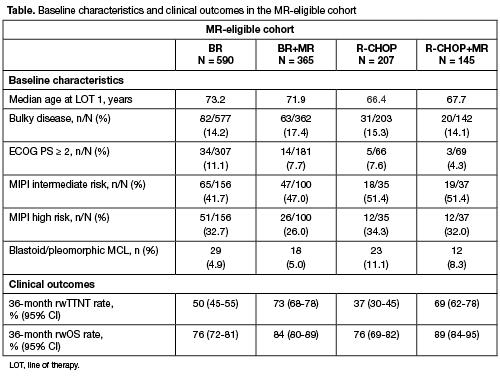
Contributions
Abstract: EP785
Type: E-Poster Presentation
Session title: Indolent and mantle-cell non-Hodgkin lymphoma - Clinical
Background
Maintenance with rituximab (MR) after 1L R-CHOP improved overall survival (OS) in both young and elderly pts with MCL in clinical trials. How MR is used in routine clinical practice and the benefits of MR after 1L BR are less defined.
Aims
To evaluate the RW patterns and outcomes of MR after 1L BR or R-CHOP in a large US MCL cohort.
Methods
This retrospective study included adult pts with MCL diagnosed Jan 2011-Nov 2020 in the nationwide Flatiron Health EHR-derived deidentified database. MR is defined in pts who received 1L induction combination with R, and R was continued as monotherapy for ≥28 days. Pt characteristics, treatment patterns, RW time to next treatment (rwTTNT, defined as start of 1L treatment to subsequent treatment or death), and rwOS were evaluated for pts treated with 1L BR or R-CHOP±MR (“entire cohort”). Considering the potential for selection biases in the application of MR, analyses were also performed in pts who were alive and did not initiate subsequent treatment within 8 months of starting 1L BR or within 6 months of 1L R-CHOP (“MR-eligible cohort”). Multivariate analyses (MVA) were performed for rwTTNT/OS on the effects of MR adjusting for age, ECOG PS, LDH, WBC, and blastoid/pleomorphic and bulky disease status.
Results
Among 2946 pts with documented 1L MCL treatment, 86.3% were from community oncology setting. In the entire cohort, 854 pts received BR alone (median duration of treatment [mDOT]: 4.1 months), 368 received BR+MR (mDOT: 25.7 months), 365 received R-CHOP alone (mDOT: 3.5 months), and 147 received R-CHOP+MR (mDOT: 26.9 months). Median age of pts starting 1L BR±MR (72.8 years) was older than pts starting 1L R-CHOP±MR (66.4 years). A lower proportion of pts receiving BR+MR had high-risk MCL international prognostic index (MIPI; 26.0% vs 38.0%) and blastoid/pleomorphic MCL (4.9% vs 7.5%) vs BR alone. With estimated median follow-up of 39.8 months (range 0.03-117.1) for BR±MR and 61.0 months (range 0.03-115.0) for R-CHOP±MR, the 36-month rwTTNT rate was the highest with BR+MR (72%), followed by R-CHOP+MR (68%). Median rwTTNT was reached at 17.0 and 7.8 months for BR and R-CHOP alone, respectively.
In the MR-eligible cohort, 590 pts received BR alone (mDOT: 4.67 months), 365 received BR+MR (mDOT: 25.8 months), 207 received R-CHOP alone (mDOT: 4.0 months), and 145 received R-CHOP+MR (mDOT: 26.9 months). Disease characteristics of intermediate/high MIPI or blastoid/pleomorphic biology were similar among those treated with BR/R-CHOP only vs those with BR/R-CHOP+MR (Table). MVA showed that MR was independently associated with longer rwTTNT (hazard ratio [HR] 0.45; 95% confidence interval [CI], 0.38-0.53; p <0.001) and rwOS (HR 0.56; 95% CI, 0.45-0.7; p <0.001). With estimated median follow-up of 38.9 months (range 0.03-117.1) for BR±MR and 64.3 months (range 0.03-115.0) for R-CHOP±MR, the 36-month rwTTNT rate was 73% for BR+MR and 69% for R-CHOP+MR. Estimated median rwTTNT was reached at 36 and 21.5 months for BR and R-CHOP alone, respectively. The 36-month rwOS rate was 84% for BR+MR, 76% for BR alone, 89% for R-CHOP+MR, and 76% for R-CHOP alone.

Conclusion
This is the largest RW cohort of pts with MCL who were treated with 1L BR or R-CHOP followed by MR. MR was associated with improved rwTTNT and rwOS. The best rwTTNT rate was seen with 1L BR+MR. The phase 3 SHINE study (NCT01776840) is evaluating the potential benefit of adding ibrutinib to BR with R maintenance in pts with previously untreated MCL.
Keyword(s): Maintenance, Mantle cell lymphoma, Non-Hodgkin's lymphoma, Rituximab
Abstract: EP785
Type: E-Poster Presentation
Session title: Indolent and mantle-cell non-Hodgkin lymphoma - Clinical
Background
Maintenance with rituximab (MR) after 1L R-CHOP improved overall survival (OS) in both young and elderly pts with MCL in clinical trials. How MR is used in routine clinical practice and the benefits of MR after 1L BR are less defined.
Aims
To evaluate the RW patterns and outcomes of MR after 1L BR or R-CHOP in a large US MCL cohort.
Methods
This retrospective study included adult pts with MCL diagnosed Jan 2011-Nov 2020 in the nationwide Flatiron Health EHR-derived deidentified database. MR is defined in pts who received 1L induction combination with R, and R was continued as monotherapy for ≥28 days. Pt characteristics, treatment patterns, RW time to next treatment (rwTTNT, defined as start of 1L treatment to subsequent treatment or death), and rwOS were evaluated for pts treated with 1L BR or R-CHOP±MR (“entire cohort”). Considering the potential for selection biases in the application of MR, analyses were also performed in pts who were alive and did not initiate subsequent treatment within 8 months of starting 1L BR or within 6 months of 1L R-CHOP (“MR-eligible cohort”). Multivariate analyses (MVA) were performed for rwTTNT/OS on the effects of MR adjusting for age, ECOG PS, LDH, WBC, and blastoid/pleomorphic and bulky disease status.
Results
Among 2946 pts with documented 1L MCL treatment, 86.3% were from community oncology setting. In the entire cohort, 854 pts received BR alone (median duration of treatment [mDOT]: 4.1 months), 368 received BR+MR (mDOT: 25.7 months), 365 received R-CHOP alone (mDOT: 3.5 months), and 147 received R-CHOP+MR (mDOT: 26.9 months). Median age of pts starting 1L BR±MR (72.8 years) was older than pts starting 1L R-CHOP±MR (66.4 years). A lower proportion of pts receiving BR+MR had high-risk MCL international prognostic index (MIPI; 26.0% vs 38.0%) and blastoid/pleomorphic MCL (4.9% vs 7.5%) vs BR alone. With estimated median follow-up of 39.8 months (range 0.03-117.1) for BR±MR and 61.0 months (range 0.03-115.0) for R-CHOP±MR, the 36-month rwTTNT rate was the highest with BR+MR (72%), followed by R-CHOP+MR (68%). Median rwTTNT was reached at 17.0 and 7.8 months for BR and R-CHOP alone, respectively.
In the MR-eligible cohort, 590 pts received BR alone (mDOT: 4.67 months), 365 received BR+MR (mDOT: 25.8 months), 207 received R-CHOP alone (mDOT: 4.0 months), and 145 received R-CHOP+MR (mDOT: 26.9 months). Disease characteristics of intermediate/high MIPI or blastoid/pleomorphic biology were similar among those treated with BR/R-CHOP only vs those with BR/R-CHOP+MR (Table). MVA showed that MR was independently associated with longer rwTTNT (hazard ratio [HR] 0.45; 95% confidence interval [CI], 0.38-0.53; p <0.001) and rwOS (HR 0.56; 95% CI, 0.45-0.7; p <0.001). With estimated median follow-up of 38.9 months (range 0.03-117.1) for BR±MR and 64.3 months (range 0.03-115.0) for R-CHOP±MR, the 36-month rwTTNT rate was 73% for BR+MR and 69% for R-CHOP+MR. Estimated median rwTTNT was reached at 36 and 21.5 months for BR and R-CHOP alone, respectively. The 36-month rwOS rate was 84% for BR+MR, 76% for BR alone, 89% for R-CHOP+MR, and 76% for R-CHOP alone.

Conclusion
This is the largest RW cohort of pts with MCL who were treated with 1L BR or R-CHOP followed by MR. MR was associated with improved rwTTNT and rwOS. The best rwTTNT rate was seen with 1L BR+MR. The phase 3 SHINE study (NCT01776840) is evaluating the potential benefit of adding ibrutinib to BR with R maintenance in pts with previously untreated MCL.
Keyword(s): Maintenance, Mantle cell lymphoma, Non-Hodgkin's lymphoma, Rituximab


